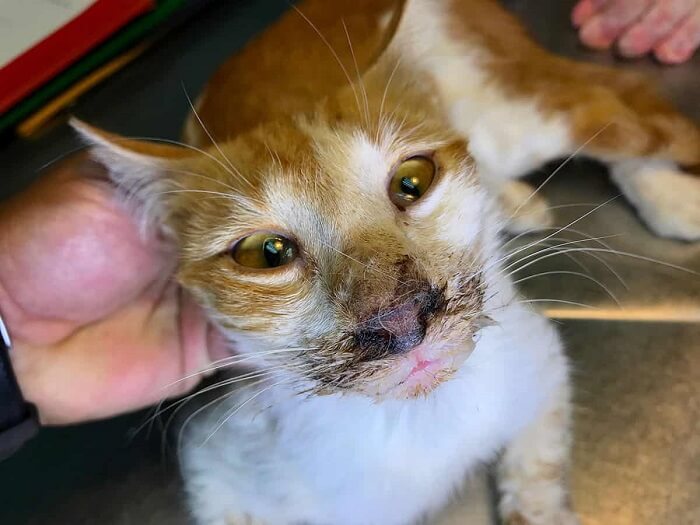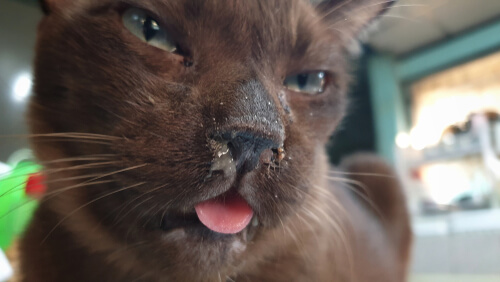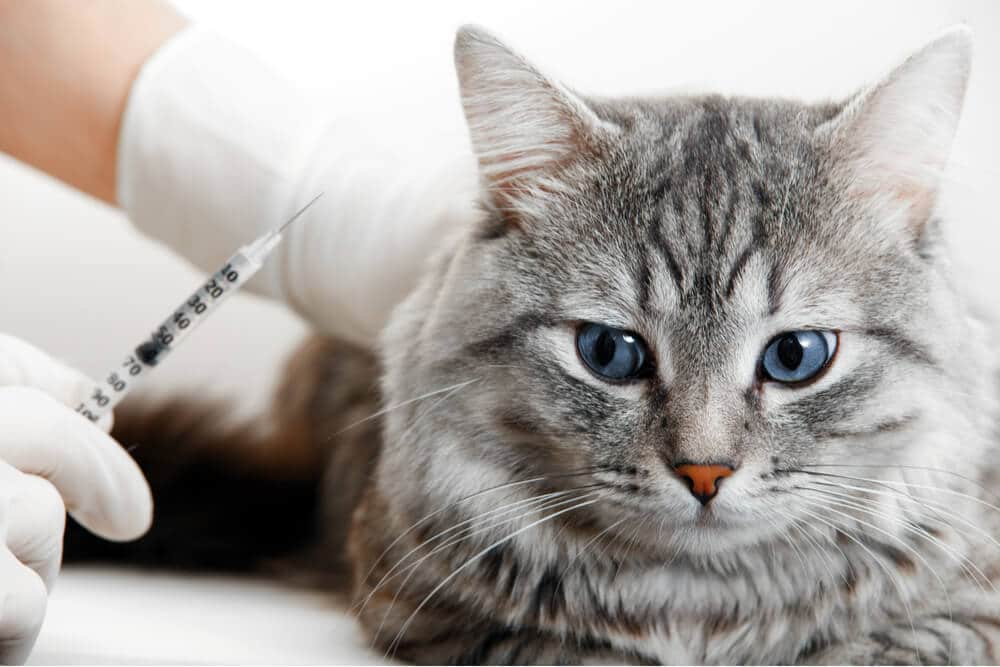
Feline calicivirus (FCV) is a common viral infection of domestic cats. The virus causes upper respiratory disease that often closely resembles Feline Viral Rhinotracheitis (FVR), and both viruses can cause the syndrome known as “Cat Flu”, with generalised inflammation of the upper respiratory tract and eyes, leading to sneezing, bilateral ocular discharge, a high temperature, dullness and inappetence.
While most cats eventually recover, fatalities do occur, and many recovered cats become chronic carriers of the virus. Vaccines given to kittens, with booster vaccinations in later life as needed, ensure that FCV is usually effectively controlled in pet cats. Colonies of feral cats can suffer serious problems from the virus. There are nearly fifty strains of Feline Calicivirus, causing disease of variable virulence and severity.
Feline Calicivirus Transmission
Feline Calicivirus is shed from infected cats primarily in discharges from the eyes, nose and mouth, and it can also be found in blood, urine and feces. Cats can be infected by direct cat-to-cat contact (droplets can carry the virus for a distance of up to 1.5m) and also via fomites (e.g. food bowls, water bowls, litter boxes etc).
Careful cleaning and disinfection is important when treating infected cats to prevent accidental transmission of the virus.
Calicivirus Symptoms

The acute form of calicivirus can cause upper respiratory symptoms, including a runny nose and eyes.
The clinical signs of Feline Calicivirus infection vary from cat to cat, from asymptomatic carriers to varying degrees of upper respiratory disease (from mild to severe). Rarely, the disease can even be fatal.
The acute form of the disease usually causes typical upper respiratory signs, which include nasal discharge and sneezing, along with conjunctivitis and ocular discharge. Many cats develop distinctive ulcerations on the tongue, gums, hard palate (roof of mouth) and lips. Pyrexia, dullness and inappetance are commonly seen.
In some cases, pneumonia may develop, with coughing and difficulty breathing. Less commonly, lameness can occur due to involvement of the joints. More virulent strains of FCV may cause other serious signs, including jaundice, edema of the head and limbs, and ulcerations elsewhere on the body.
Some cats develop the chronic (long term) signs of disease, which can include gingivitis and nasopharyngeal polyps, as well as shedding of the virus into the long term. Around 80% of cats that recover from FCV go on to become chronic carriers of the virus.
Calicivirus Treatment
In theory, anti-viral therapy (such as interferon or immunoglobulin therapy) may be given, but in practice, this is rarely used.
Instead, the focus is on supportive therapy, keeping affected cats comfortable while the cat’s own immune system deals with the virus.
- This supportive treatment may include general nursing, antibiotics to control secondary bacterial infection, phenylephrine nasal drops as a decongestant, intra-venous fluids to combat dehydration, and nutritional support.
- Affected cats often lose their sense of smell, resulting in simultaneous loss of taste, so it’s helpful to offer highly palatable foods with a strong, attractive odor, warming food in the microwave to make it more appealing.
- Cleaning of discharges from the eyes and nostrils several times daily is important, using cotton wool moistened with warm water. It can help to add 1 teaspoonful of salt to 1 pint of water.
Most (but not all) cats gradually recover from the acute, active, phase of illness over a period of 7 – 10 days.
Calicivirus Vaccine

Vaccination against feline calicivirus is the best way to prevent this condition.
Effective vaccination against FCV is available: this is part of the routine FVRCP vaccine that’s given to kittens, with adult cats being given regular booster vaccinations at intervals appropriate to their lifestyle. In general, the primary series of vaccinations against FVRCP should be given to all kittens and cats.
Indoor adult cats may be given booster vaccinations every three years to maintain minimal immunity. Cats that go outside, mingling with other cats, or cats that go to boarding catteries or shows, may be given an annual booster vaccination, but this is a topic for discussion with your own vet. Vaccinations should be given at intervals based on an individual risk assessment for each patient.
Current advice from the American Association of Feline Practitioners (AAFP) Panel recommends that the first dose of vaccine should be given at 9 weeks of age, a second dose at 12 weeks, and a third dose at 16 weeks of age. A booster vaccination should then be given one year later, followed by further boosters every three years.
These recommendations are based on an “average” cat, and it’s always worth discussing your own cat’s needs with your own veterinarian.
Can Calicivirus Be Transmitted from Cats to Humans?
The chronic form of calicivirus describes the common situation where a cat recovers from acute calicivirus infection, but they then carry the virus in their system for the rest of their lives, intermittently showing clinical signs (e.g. if they get stressed) and shedding the virus too. The virus cannot be transmitted to owners, but there is a general rule that if you have a sick cat (e.g. sneezing etc) then you should not allow them to come very close to you, or to sneeze in your face. There is a low risk of you picking something up, but even a small risk like this should be avoided, by reducing the contact between you and your cat at these times.
Conclusion
Along with Feline Viral Rhinotracheitis (FVR), Feline Calicivirus (FCV) is one of the most common viral infection of cats, with one or both viruses causing the syndrome known as “cat flu”. The disease can be prevented by vaccinations which should be given to all kittens, and to adult cats as needed depending on their individual risk.







